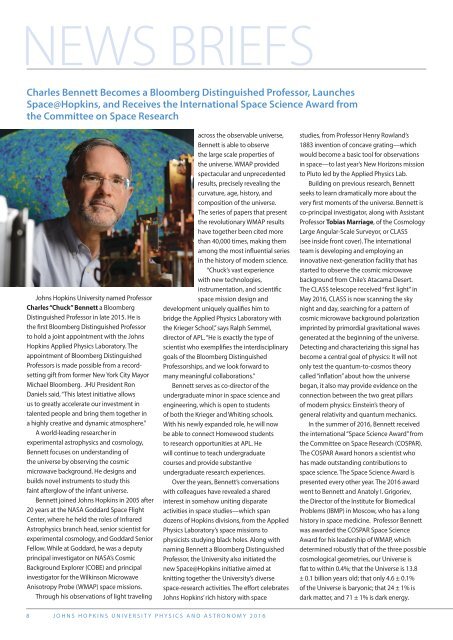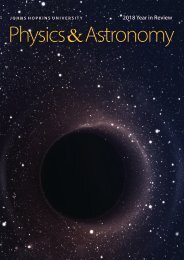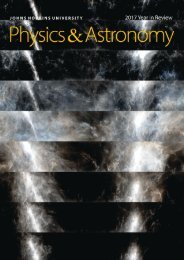2016_PA_Newsletter_12_29_16_FINAL
Create successful ePaper yourself
Turn your PDF publications into a flip-book with our unique Google optimized e-Paper software.
NEWS BRIEFS<br />
Charles Bennett Becomes a Bloomberg Distinguished Professor, Launches<br />
Space@Hopkins, and Receives the International Space Science Award from<br />
the Committee on Space Research<br />
Johns Hopkins University named Professor<br />
Charles “Chuck” Bennett a Bloomberg<br />
Distinguished Professor in late 2015. He is<br />
the first Bloomberg Distinguished Professor<br />
to hold a joint appointment with the Johns<br />
Hopkins Applied Physics Laboratory. The<br />
appointment of Bloomberg Distinguished<br />
Professors is made possible from a recordsetting<br />
gift from former New York City Mayor<br />
Michael Bloomberg. JHU President Ron<br />
Daniels said, “This latest initiative allows<br />
us to greatly accelerate our investment in<br />
talented people and bring them together in<br />
a highly creative and dynamic atmosphere.”<br />
A world‐leading researcher in<br />
experimental astrophysics and cosmology,<br />
Bennett focuses on understanding of<br />
the universe by observing the cosmic<br />
microwave background. He designs and<br />
builds novel instruments to study this<br />
faint afterglow of the infant universe.<br />
Bennett joined Johns Hopkins in 2005 after<br />
20 years at the NASA Goddard Space Flight<br />
Center, where he held the roles of Infrared<br />
Astrophysics branch head, senior scientist for<br />
experimental cosmology, and Goddard Senior<br />
Fellow. While at Goddard, he was a deputy<br />
principal investigator on NASA’s Cosmic<br />
Background Explorer (COBE) and principal<br />
investigator for the Wilkinson Microwave<br />
Anisotropy Probe (WMAP) space missions.<br />
Through his observations of light traveling<br />
across the observable universe,<br />
Bennett is able to observe<br />
the large scale properties of<br />
the universe. WMAP provided<br />
spectacular and unprecedented<br />
results, precisely revealing the<br />
curvature, age, history, and<br />
composition of the universe.<br />
The series of papers that present<br />
the revolutionary WMAP results<br />
have together been cited more<br />
than 40,000 times, making them<br />
among the most influential series<br />
in the history of modern science.<br />
“Chuck’s vast experience<br />
with new technologies,<br />
instrumentation, and scientific<br />
space mission design and<br />
development uniquely qualifies him to<br />
bridge the Applied Physics Laboratory with<br />
the Krieger School,” says Ralph Semmel,<br />
director of APL. “He is exactly the type of<br />
scientist who exemplifies the interdisciplinary<br />
goals of the Bloomberg Distinguished<br />
Professorships, and we look forward to<br />
many meaningful collaborations.”<br />
Bennett serves as co-director of the<br />
undergraduate minor in space science and<br />
engineering, which is open to students<br />
of both the Krieger and Whiting schools.<br />
With his newly expanded role, he will now<br />
be able to connect Homewood students<br />
to research opportunities at APL. He<br />
will continue to teach undergraduate<br />
courses and provide substantive<br />
undergraduate research experiences.<br />
Over the years, Bennett’s conversations<br />
with colleagues have revealed a shared<br />
interest in somehow uniting disparate<br />
activities in space studies—which span<br />
dozens of Hopkins divisions, from the Applied<br />
Physics Laboratory’s space missions to<br />
physicists studying black holes. Along with<br />
naming Bennett a Bloomberg Distinguished<br />
Professor, the University also initiated the<br />
new Space@Hopkins initiative aimed at<br />
knitting together the University’s diverse<br />
space-research activities. The effort celebrates<br />
Johns Hopkins’ rich history with space<br />
studies, from Professor Henry Rowland’s<br />
1883 invention of concave grating—which<br />
would become a basic tool for observations<br />
in space—to last year’s New Horizons mission<br />
to Pluto led by the Applied Physics Lab.<br />
Building on previous research, Bennett<br />
seeks to learn dramatically more about the<br />
very first moments of the universe. Bennett is<br />
co-principal investigator, along with Assistant<br />
Professor Tobias Marriage, of the Cosmology<br />
Large Angular‐Scale Surveyor, or CLASS<br />
(see inside front cover). The international<br />
team is developing and employing an<br />
innovative next‐generation facility that has<br />
started to observe the cosmic microwave<br />
background from Chile’s Atacama Desert.<br />
The CLASS telescope received “first light” in<br />
May <strong>20<strong>16</strong></strong>, CLASS is now scanning the sky<br />
night and day, searching for a pattern of<br />
cosmic microwave background polarization<br />
imprinted by primordial gravitational waves<br />
generated at the beginning of the universe.<br />
Detecting and characterizing this signal has<br />
become a central goal of physics: It will not<br />
only test the quantum-to-cosmos theory<br />
called “inflation” about how the universe<br />
began, it also may provide evidence on the<br />
connection between the two great pillars<br />
of modern physics: Einstein’s theory of<br />
general relativity and quantum mechanics.<br />
In the summer of <strong>20<strong>16</strong></strong>, Bennett received<br />
the international “Space Science Award” from<br />
the Committee on Space Research (COS<strong>PA</strong>R).<br />
The COS<strong>PA</strong>R Award honors a scientist who<br />
has made outstanding contributions to<br />
space science. The Space Science Award is<br />
presented every other year. The <strong>20<strong>16</strong></strong> award<br />
went to Bennett and Anatoly I. Grigoriev,<br />
the Director of the Institute for Biomedical<br />
Problems (IBMP) in Moscow, who has a long<br />
history in space medicine. Professor Bennett<br />
was awarded the COS<strong>PA</strong>R Space Science<br />
Award for his leadership of WMAP, which<br />
determined robustly that of the three possible<br />
cosmological geometries, our Universe is<br />
flat to within 0.4%; that the Universe is 13.8<br />
± 0.1 billion years old; that only 4.6 ± 0.1%<br />
of the Universe is baryonic; that 24 ± 1% is<br />
dark matter, and 71 ± 1% is dark energy.<br />
8 JOHNS HOPKINS UNIVERSITY PHYSICS AND ASTRONOMY <strong>20<strong>16</strong></strong>










